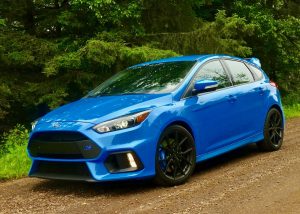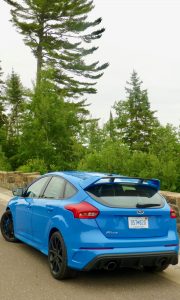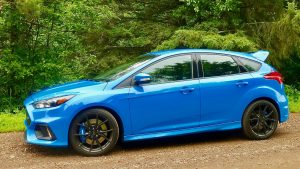RS gives U.S. buyers new Focus on fun
By John Gilbert
What’s in a name, especially a car name? Maybe it’s all in the eye of the beholder. If you ask a long-time car owner what he or she thinks of the Ford Focus, chances are you will elicit a frown, maybe a muttering that ranges from OK and adequate to boring, or mundane.
Ah, but a car’s name also demands that you add the initials. For example, RS after the word Focus. All the years we’ve been buying or settling for a Ford Focus because it’s inexpensive to buy and operate, in a world where fitting into a budget is more important than seeking something exotic, we have also heard about how lucky Europeans are, because they get a top-end Focus that remained only a rumor in the U.S. Still reasonably priced, they said, but equipped with power and potential to compete with the true hot small cars. Think GTI R, or WRX STi.
Now we can redirect the question: What do you think about the Ford Focus RS?
If you ask someone who has been to Europe, or knows something about cars, their eyes will light up and a smile will crease their faces.
At long last, Ford has brought the Focus RS to the United States, and it lives up to all you’ve ever heard about it. I got my hands on one for a week, and one word of advice: When you get your hands on a Focus RS, hang on!
The car stood out because it was painted “Nitrous Blue Quad-Coat,” a color remindful of the electric-blue that Richard Petty’s NASCAR race cars used to be. Only this one is highly metallic, as you can see when you get up close and let the sun reflect off its bright skin.
The Focus RS looks as menacing as a Focus can look, but that doesn’t cover the territory. A Focus is a compact, front-wheel drive 4-cylinder with 120-some horsepower, aimed at fuel economy more than sprightly performance.
The RS has a turbocharged direct-injected 2.3-liter 4 with all-wheel drive and a 6-speed stick shift, with — get this — 350 horsepower and another 350 foot-piunds of torque.
Push the button and start up. Maybe it’s been a while since you drove a hot 6-speed stick, so be careful. Oops! Killed the engine. It takes some adjustment on the driver’s part. You figure if you let the clutch out too soon, you kill the engine, so let it out more easily, and it simply hurls you across the intersection. You get the distinct feeling that if you timed it just right, you could probably throw the Focus RS into an endless whirl of burnout spins until the tires melted.
As a matter of fact, there are four settings for the drive characteristics: Normal, Sport, Track, and Drift. Now, “Drift” is something I can’t wrap my brain around. I know there are actual competitions where drivers roar around race tracks and the winner is the one who can throw his car out of line, nearly out of control, and then control it through the turns by cracking the steering wheel to somewhat control the skidding, drifting, sliding tendencies. The Focus RS has an actual setting to enhance that practice.
But if you can control the urge to get as close to out-of-control as possible without losing it, you might have to accept that the AWD Focus RS simply handles every “normal” driving challenge with superb handling. Tight curves, cloverleafs, abrupt emergency-handling swerves — all of them become easily conquered.
The Focus RS is a 4-door sedan, and there is room to fit two occupants in the back seat. They, in fact, might not mind being squeezed a little, just because the car looks so enticing.
With surprisingly good cargo space under the rear hatch, the roominess is an asset. The styled alloy wheels cover body-color Brembo disc brake units, but let’s get back inside.
Driver and front passenger sit in Recaro bucket seats, and I do emphasize the word “in.” Most car seats you sit on, but in form-fitting Recaros, you sink down into them, with side bolsters sealing you in to hold you in position no matter how aggressively you might swerve. Or, as they say, drift.
Some people don’t like Recaros, finding the severe side support wears on your thighs over the long haul. Personally, I like them. If you’re sitting on a normal seat, you might prefer to move around and adjust your sitting angle, but I think your driving focus improves when you have not choice but to sit in a full-focused position.
The 6-speed stick is smooth and easy to shift, and once you get disciplined to launching somewhere between kill-the-engine and hurl-across-the-intersection, sending the Focus RS around on your intended vectors is sheer pleasure.
Handling is aided by firm suspension and that all-wheel drive system, and the low-profile, high-performance Michelin Cup-2 track tires on 19-inch forged alloy wheels keep everything planted even more.
Having to wait a few styling generations to get our American hands on the RS has its benefits. The many safety and driver-assist systems that have been invented and become prevalent since it was introduced in Europe now makes the U.S. issue RS a much more refined car.
Along with the obvious things like the spoiler high on the rear roof and the badging, along with the unique color, the items under the skin include bi-xenon headlights with cornering capability, blind-spot warning LED lights on the side mirrors, dynamic torque vectoring on the AWD system, launch control, advance trac stability control, voice-activated navigation, SYNC connectivity, and perimeter alarm.
You might find an ordinary garden-variety Focus for under $20,000, and you could be happy with normal driving routines and decent fuel economy. But you know you’re going to pay extra for the hot Focus RS. Base price of the RS is $35,900 for the turbo, AWD, and interior and handling amenities. As tested, the model I drove was $41,370.
But when somebody asks you what you drive, you wouldn’t have to say you got the “$40,000 Focus,” you can just say the Focus RS and see if they light up. If they do, you know they appreciate what you’ve got. If they don’t…well, they probably wouldn’t have asked what you drive in the first place.







 John Gilbert is a lifetime Minnesotan and career journalist, specializing in cars and sports during and since spending 30 years at the Minneapolis Tribune, now the Star Tribune. More recently, he has continued translating the high-tech world of autos and sharing his passionate insights as a freelance writer/photographer/broadcaster. A member of the prestigious North American Car and Truck of the Year jury since 1993. John can be heard Monday-Friday from 9-11am on 610 KDAL(www.kdal610.com) on the "John Gilbert Show," and writes a column in the Duluth Reader.
John Gilbert is a lifetime Minnesotan and career journalist, specializing in cars and sports during and since spending 30 years at the Minneapolis Tribune, now the Star Tribune. More recently, he has continued translating the high-tech world of autos and sharing his passionate insights as a freelance writer/photographer/broadcaster. A member of the prestigious North American Car and Truck of the Year jury since 1993. John can be heard Monday-Friday from 9-11am on 610 KDAL(www.kdal610.com) on the "John Gilbert Show," and writes a column in the Duluth Reader.